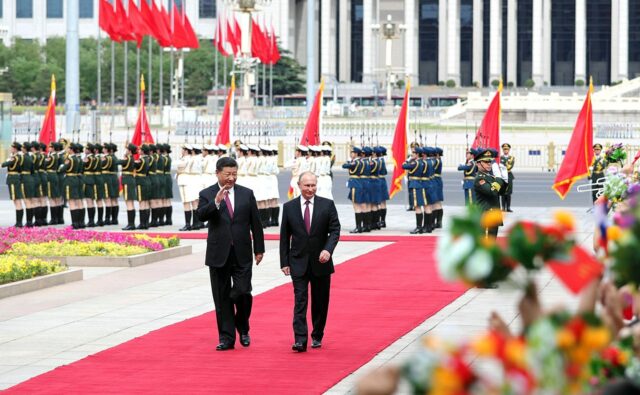
Geopolitical Report ISSN 2785-2598 Volume 40 Issue 11
SpecialEurasia OSINT Team
The landscape of foreign direct investment (FDI) in Kyrgyzstan highlights the China-Russia competition in the Central Asian republic, with China emerging as the principal investor, surpassing Russia and Kazakhstan.
China’s investments primarily target manufacturing, mining, and financial sectors, aligning with its strategic interests in energy and infrastructure projects. Russia, historically a significant player in Kyrgyzstan’s economy, maintains robust economic ties and security collaboration, yet faces challenges, such as diminishing cultural ties and linguistic shifts.
The geopolitical dynamics underscore competition between China and Russia for influence, with China’s Belt and Road Initiative intensifying investment rivalry.
This report delves into the implications of these dynamics, highlighting their significance for regional stability and Kyrgyzstan’s economic development.
China-Russia’s Investments and Kyrgyzstan:
Background Information
Preliminary data from the National Statistics Committee reveals China became the primary provider of foreign direct investment (FDI) in Kyrgyzstan in 2023. With a total influx of $798.2 million into the Kyrgyz economy, China’s contribution stood at $220.8 million, overshadowing investments from Russia and Kazakhstan, which amounted to $180.3 million and $132.1 million, respectively.
Notably, China allocated most of these funds to key sectors, such as manufacturing, mining, and financial intermediation, with investments of $226.4 million, $169.2 million, and $156.8 million, respectively.
Conversely, sectors such as education, arts, and water supply received minimal investments, with respective amounts of $120.4 thousand, $69.9 thousand, and $16.6 thousand, showing potential areas for future development.
Despite the significant FDI inflow, there was a notable decrease compared to the previous year, with the flow of foreign direct investment into Kyrgyzstan declining by $404.3 million. Concurrently, outflows of investments, primarily from China and Russia, amounted to $307.8 million, with China accounting for $187.9 million and Russia for $40.4 million.
Read also | Geopolitics of Russia’s Language Schools in Kyrgyzstan |
Why Does It Matter?
The emergence of China as the primary investor in Kyrgyzstan has brought about a significant shift in the economic landscape, intensifying competition with Russia for influence within the region.
Despite maintaining robust economic ties and security collaboration with Kyrgyzstan, Russia faces challenges to diminish cultural cooperation and linguistic shifts.
The substantial joint ventures and investments between Russia and Kyrgyzstan serve as a demonstration of the economic interdependence and security collaboration between the two nations. This is further reinforced by their integration into a unified air defence system, which indicates a heightened level of cooperation in terms of security.
Meanwhile, China’s growing influence in Kyrgyzstan is clear through strategic investments in energy projects and transit infrastructure, including initiatives like the China-Kyrgyzstan-Uzbekistan railway, which shortens the route from China to the Middle East.
Energy sector cooperation between China and Kyrgyzstan, as demonstrated by agreements on hydroelectric power stations and a solar power plant, further solidifies China’s foothold in the region.
Moscow’s strategic objectives deeply intertwine with the geopolitical dynamics of Central Asia, particularly in Kyrgyzstan. Russia perceives the region as part of its blizhnee zarubezhe (near abroad) and vital to its interests, actively seeking to expand its military presence and political influence. To bolster its dominance, Moscow utilises multifaceted tools such as the Eurasian Economic Union (EAEU) and the Collective Security Treaty Organization (CSTO).
Despite outward appearances of Russia’s unity with Beijing in Central Asia, the reality portrays a nuanced relationship marked by competition rather than seamless collaboration. China’s Belt and Road Initiative, launched in 2013, has intensified this competition significantly, with Beijing aggressively funding and spearheading local infrastructural projects to bolster its influence in the region.
Looking ahead, the ongoing competition between China and Russia will influence the future dynamics in Kyrgyzstan’s investment landscape. China’s Belt and Road Initiative will continue to drive investments in energy and infrastructure projects, challenging Russia’s historic dominance. However, Russia’s strategic interests in Central Asia show sustained efforts to maintain influence.
Conclusion
The competition between Russia and China in the investment sectors of Kyrgyzstan could yield positive outcomes by attracting more financial support for socioeconomic development projects and local companies.
The increased competition may push both Moscow and Beijing to offer more favourable terms and incentives, ultimately benefiting Kyrgyzstan’s economy. However, there is a significant risk that this competition could polarise the investment market, potentially limiting opportunities for other foreign companies to participate and take the lead in the Kyrgyz sectors.
In the broader geopolitical context, while Russia and China have consistently emphasised their partnership and commitment to countering Western influence in Central Asia, there is a plausible long-term risk of Moscow and Beijing transitioning from partners to competitors in the region.
Such a scenario could significantly affect regional dynamics, particularly in Kyrgyzstan, given its substantial reliance on Moscow’s political and military support and Beijing’s financial help.
Therefore, Bishkek’s response to these dynamics, including its economic policies and regional engagements, will shape its trajectory in Moscow-Beijing’s competition. Efforts to balance economic interests with security considerations will be pivotal for ensuring stability and prosperity in the region.
Read also | Geopolitics of Contemporary Kirgyzstan between Russia, China, and Turkey |
For those with an interest in acquiring comprehensive insights into the dynamics of the Kyrgyzstan and the Central Asia, we encourage you to reach out to our team by emailing info@specialeurasia.com. We are ready to assist you in assessing the opportunity to obtain a meticulously crafted and specialised report tailored to your intelligence needs.
